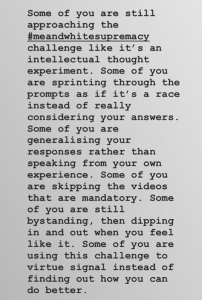In Sujata Moorti’s classes, we discussed how gender is a construct consisting of gender roles and gender scripts that are culturally conditioned, the intersectionality of gender with the other categories that divide people, and the relational, contextual quality of gender performance.
I have prided myself before in understanding these concepts, but I had actually come to the realization before this course that I was not as enlightened as I thought I was, that I had not made mental space for gender fluidity in other people because I was so clear in categorizing myself as a woman. So I examined my own attitudes during this session, and realized something interesting: even though I agreed that gender roles were fully constructed and not natural or intrinsic to us, I still felt like there was something about me that was intrinsically female! But Sujata’s point was that culturally-conditioned gender roles and norms are all there is in regards to gender – in fact, scientists have been unable to prove that there is anything intrinsically male or intrinsically female. Cultures differ in what we think are appropriate roles for men and women.
I think what my experience illustrates is that gender roles are so deeply ingrained to feel natural to the extent that, even if I reject that having the female sex makes me naturally follow my culture’s female gender roles, I still feel like something about being a women is natural to me. I have long been aware that this is the case, and in fact I have felt relieved by it, thinking how it makes life easier when you feel comfortable in your gender role. Even as I reject notions that being a woman means I must do certain things and not do others, I still fundamentally embrace the notion of gender as intrinsic: I am not really seeing the construct, just trying to change the range of activities acceptable to women so that I will not feel constrained in my role.
A basic realization that emerged from the feminist movement, especially the third wave, is that just because women are female does not mean they have anything in common. It can be convenient to convene women’s groups based on the idea that the people will connect just because they are female, or to claim solidarity with women around the world just because they are also female. But other social categories – race, class, etc. – play a role in dividing people as well.
This realization could be helpful to me by driving home another point Sujata made, which is that women need to be included in community development and peacebuilding process, not because they are intrinsically better at peace but because they are part of the community, and everyone must be included. In fact, I think a fundamental tenet of peacebuilding is that everyone must be included. You cannot build a partial peace. Inequality is often a symptom of structural or cultural violence.









 Dr. Sunjata Moorti came in to speak with us about the role of gender, specifically, as it relates to peace and conflict. She had us introduce ourselves with a bit about our relation to gender, and it caused me to think back to my senior year of high school where I put together a final presentation on gender roles for my favorite class (one that fused language arts and social studies for all 4 years within a community where freshman, sophomores, juniors, and seniors were all mixed in classes together). I highlighted several advertisements that reinforced ideas that boys should be builders, loud, rambunctious, and like things like guns and cars, while girls had toys that almost always tied to motherhood (e.g. baby dolls, my little pony, etc.) or life in the domestic sphere (e.g. easy-bake ovens). I chose this topic because I am (and was then) a feminist, and I strongly rejected the notion that gender was a binary and static. As I really developed an understanding of in my undergraduate career, gender is on a continuum and fluid. This means that everyone has traits that would fall into the categories of “masculine” and “feminine,” and no one is a perfect image of one of the two, and it also means that ones conceptualization of gender changes over time and with new experiences. This doesn’t mean that everyone “changes” genders, but rather that their gender will mean (slightly or significantly) different things, and could be expressed very differently throughout one’s lifetime. In thinking of gender, I also remembered the strong influence I gained from an inspirational feminist to me, Kimberlé Crenshaw, who coined the term “intersectionality” to describe the interconnected nature of various aspects of our identities (e.g. race, gender, sexuality, etc.). Since coming into contact with Crenshaw’s work, I have internalized this concept and applied it as a lens to view the world, especially in my work promoting social justice. As we discussed in class, this concept was also crucial to the 3rd wave of feminism in the US from the 1980s-2000s, which recognized that there is not singular category woman, and that intersections of all aspects of one’s identity shape their notion of “woman.”
Dr. Sunjata Moorti came in to speak with us about the role of gender, specifically, as it relates to peace and conflict. She had us introduce ourselves with a bit about our relation to gender, and it caused me to think back to my senior year of high school where I put together a final presentation on gender roles for my favorite class (one that fused language arts and social studies for all 4 years within a community where freshman, sophomores, juniors, and seniors were all mixed in classes together). I highlighted several advertisements that reinforced ideas that boys should be builders, loud, rambunctious, and like things like guns and cars, while girls had toys that almost always tied to motherhood (e.g. baby dolls, my little pony, etc.) or life in the domestic sphere (e.g. easy-bake ovens). I chose this topic because I am (and was then) a feminist, and I strongly rejected the notion that gender was a binary and static. As I really developed an understanding of in my undergraduate career, gender is on a continuum and fluid. This means that everyone has traits that would fall into the categories of “masculine” and “feminine,” and no one is a perfect image of one of the two, and it also means that ones conceptualization of gender changes over time and with new experiences. This doesn’t mean that everyone “changes” genders, but rather that their gender will mean (slightly or significantly) different things, and could be expressed very differently throughout one’s lifetime. In thinking of gender, I also remembered the strong influence I gained from an inspirational feminist to me, Kimberlé Crenshaw, who coined the term “intersectionality” to describe the interconnected nature of various aspects of our identities (e.g. race, gender, sexuality, etc.). Since coming into contact with Crenshaw’s work, I have internalized this concept and applied it as a lens to view the world, especially in my work promoting social justice. As we discussed in class, this concept was also crucial to the 3rd wave of feminism in the US from the 1980s-2000s, which recognized that there is not singular category woman, and that intersections of all aspects of one’s identity shape their notion of “woman.”






